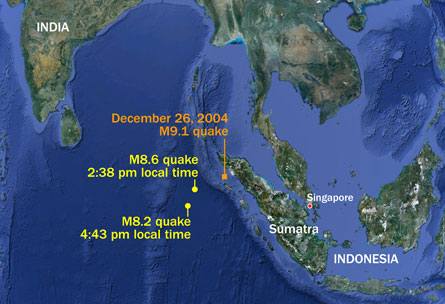Big quake, little destruction
A large earthquake rattles Indonesia without unleashing a damaging tsunami
By Erin Wayman

A massive earthquake shook Southeast Asia on April 11 at 2:38 p.m. local time. Just a couple hours later, a large follow-up earthquake struck the same region. Fortunately, neither quake caused much damage.
The main earthquake occurred 400 kilometers (250 miles) off the west coast of the island of Sumatra in Indonesia, a country in the Indian Ocean. The source of the quake was about 23 kilometers (14 miles) beneath the seafloor. To locate the quake and measure its magnitude, or strength, scientists used a seismometer. This electronic device detects vibrations caused by movements in the Earth. The quake had a magnitude of 8.6 and is the ninth-largest earthquake in the last hundred years. The biggest earthquake ever recorded was a magnitude 9.5, in Chile in 1960.
Earthquakes are fairly common events, provoking tremors somewhere about 55 times each day. Many will never be felt by humans. Really large earthquakes — those with a magnitude 8 or larger — don’t happen often. On average, they rattle Earth only once a year.
The new Sumatran quake “was a big, shallow earthquake. We know that it was felt in mainland India,” Don Blakeman of the U.S. Geological Survey’s National Earthquake Information Center in Golden, Colo., told Science News. Blakeman is a geophysicist, a scientist who studies the forces that move and shape Earth.
Because the earthquake was so strong, people were afraid it would trigger a giant ocean wave called a tsunami. That’s what happened in December 2004. At that time, a magnitude 9.1 quake off Sumatra’s west coast unleashed a tsunami that flooded coastal areas. The quake and tsunami killed more than 200,000 people.
This time there was no big tsunami. Why not?
Scientists say it’s because the Earth moved in different ways during the two quakes. In 2004, the earthquake occurred where two giant, slow-moving slabs of Earth’s crust collide. These slabs, known as tectonic plates, cover the planet’s surface. The 2004 tremors happened when a part of one plate was pushed up and over a neighboring one. The upward movement released built-up energy that shook the Earth. The movement of the plate also pushed up water, sending a colossal wave rippling across the ocean.
The April 2012 earthquake was different. It did not strike on the boundary between two plates. Instead, it happened in a giant crack, or fault, in the middle of a plate. As rocks on either side of the crack slid past each other, the seafloor moved horizontally (sideways) — not vertically (up or down).
“If you don’t have vertical motion, you don’t have the process that lifts water upward,” Blakeman told Science News. That’s why there wasn’t a big tsunami even though the earthquake was powerful.
Several smaller earthquakes called aftershocks rocked the region in the days following the first tremors. Aftershocks are typical events that occur as the crustal rock settles into place after a quake.
Quakes are common in Indonesia. But scientists can’t predict when and where one will strike. That means people always have to be prepared for the next big tremor.
POWER WORDS (adapted from the New Oxford American Dictionary)
magnitude (of an earthquake) A measure of the strength of an earthquake. The stronger the earthquake, or the more energy it releases, the higher the magnitude.
geophysics The study of the physics of Earth.
tsunami A long, tall ocean wave caused by an earthquake, landslide or some other disturbance.
tectonic plate A large slab of Earth’s crust. More than a dozen major tectonic plates cover Earth’s surface like a jigsaw puzzle.







